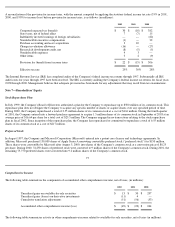Apple 2002 Annual Report Download - page 49
Download and view the complete annual report
Please find page 49 of the 2002 Apple annual report below. You can navigate through the pages in the report by either clicking on the pages listed below, or by using the keyword search tool below to find specific information within the annual report.
The estimates of fair value are based on applicable and commonly used pricing models using prevailing financial market information as of
September 28, 2002 and September 29, 2001. In certain instances where judgment is required in estimating fair value, price quotes were
obtained from several of the Company's counterparty financial institutions. Although the table above reflects the notional principal, fair value,
and credit risk amounts of the Company's interest rate and foreign exchange instruments, it does not reflect the gains or losses associated with
the exposures and transactions that the interest rate and foreign exchange instruments are intended to hedge. The amounts ultimately realized
upon settlement of these financial instruments, together with the gains and losses on the underlying exposures, will depend on actual market
conditions during the remaining life of the instruments.
Foreign Exchange Risk Management
The Company enters into foreign currency forward and option contracts with financial institutions primarily to protect against foreign exchange
risk associated with existing assets and liabilities, certain firmly committed transactions and certain probable but not firmly committed
transactions. Generally, the Company's practice is to hedge a majority of its existing material foreign exchange transaction exposures.
However, the Company may not hedge certain foreign exchange transaction exposures due to immateriality, prohibitive economic cost of
hedging particular exposures, or availability of appropriate hedging instruments.
61
In accordance with SFAS No. 133, hedges related to probable but not firmly committed transactions of an anticipatory nature are designated
and documented at hedge inception as cash flow hedges and evaluated for hedge effectiveness quarterly. For currency forward contracts, hedge
effectiveness is measured based on changes in the total fair value of the contract attributable to changes in the forward exchange rate. Changes
in the expected future cash flows on the forecasted hedged transaction and changes in the fair value of the forward hedge are both measured
from the contract rate to the forward exchange rate associated with the forward contract's maturity date.
For currency option contracts, hedge effectiveness is measured based on changes in the total fair value of the option contract. Hedge
effectiveness is assessed by comparing the present value of the cumulative change in expected future cash flows on the hedged transaction
determined as the sum of the probability-weighted outcomes with respect to the option strike rates with the total change in fair value of the
option hedge. The net gains or losses on derivative instruments qualifying as cash flow hedges are reported as components of other
comprehensive income in stockholders' equity and reclassified into earnings in the same period or periods during which the hedged transaction
affects earnings. Any residual changes in fair value of these instruments are recognized in current earnings in other income and expense.
To protect gross margins from fluctuations in foreign currency exchange rates, the Company's U.S. dollar functional subsidiaries hedge a
portion of forecasted foreign currency revenues, and the Company's non-U.S. dollar functional subsidiaries selling in local currencies hedge a
portion of forecasted inventory purchases not denominated in the subsidiaries' functional currency. Other comprehensive income associated
with hedges of foreign currency revenues is recognized as a component of net sales in the same period as the related sales are recognized, and
other comprehensive income related to inventory purchases is recognized as a component of cost of sales in the same period as the related costs
are recognized. Typically, the Company hedges portions of its forecasted foreign currency exposure associated with revenues and inventory
purchases over a time horizon of 3 to 9 months.
The Company also enters into foreign currency forward and option contracts to offset the foreign exchange gains and losses generated by the
re-measurement of certain recorded assets and liabilities in non-functional currencies. Changes in the fair value of these derivatives are
recognized in current earnings in other income and expense as offsets to the changes in the fair value of the related assets or liabilities.
The Company may enter into foreign currency forward contracts to offset the translation and economic exposure of a net investment position in
a foreign subsidiary. Hedge effectiveness on forwards designated as net investment hedges is measured based on changes in the fair value of
the contract attributable to changes in the spot exchange rate. The effective portion of the net gain or loss on a derivative instrument designated
as a hedge of the net investment position in a foreign subsidiary is reported in the same manner as a foreign currency translation adjustment.
Any residual changes in fair value of the forward contract, including changes in fair value based on the differential between the spot and
forward exchange rates are recognized in current earnings in other income and expense.
As discussed above, the Company enters into foreign currency option contracts as items that provide an offset to the re-measurement of certain
recorded assets and liabilities denominated in non-functional currencies. All changes in the fair value of these derivative contracts based on
changes in option time value are recorded in current earnings in other income and expense. Due to market movements, changes in option time
value can lead to increased volatility in other income and expense.
Derivative instruments designated as cash flow hedges must be de-designated as hedges when it is probable that the forecasted hedged
transaction will not occur in the initially identified time period or within a
62
























